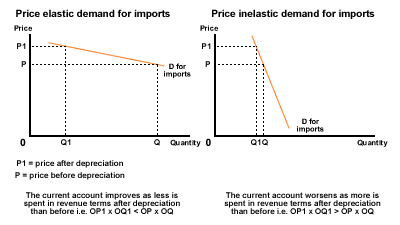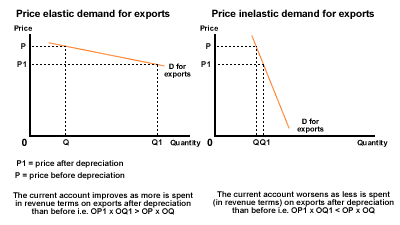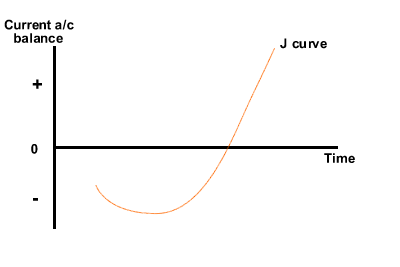Marshall-Lerner condition - HL Only!!!!
Syllabus: State the Marshall-Lerner condition.Marshall-Lerner condition
The Marshall-Lerner condition refers to the impact of a depreciation, or devaluation, of a currency on the current account of the balance of payments. The condition states that the current account will improve, after a depreciation, if the sum of the price elasticities of demand for imports and exports is greater than 1. The further above 1 the sum of the elasticities is, the greater the improvement in the current account will be.
Syllabus: Apply the Marshall-Lerner condition to the effect of devaluation/depreciation on the current account.
Marshall-Lerner condition - explanation

The depreciation of a currency will increase import prices and decrease export prices. Therefore, the more price elastic the demand for imports and exports, the greater will be the fall in demand for imports and the increase in demand for exports and the greater will be the improvement on the current account.
Follow this link for a simplified explanation and example 
It should be clear to you that if both PEDx and PEDm (where PEDx Price Elasticity of Demand for Exports PEDm Price Elasticity of Demand for Imports) are greater than one then a devaluation (depreciation) of the Exchange Rate must improve a current account deficit. What Marshall and Lerner showed was that even if both PEDs are inelastic (both less than one), as long as their sum is greater than one then the devaluation (depreciation) will be effective in reducing a BoT deficit. This is a wow moment for those who get it. If you do not then give it some thought. If you still don´t get the `wow´then as far as the IB is concerned all is fine - stick with the simple explanation above.
| The
following level of analysis is beyond the scope of the IB but just in
case you feel you need to understand it all, otherwise save for a time
you are feeling particularly contemplative (or just skip it altogether: Assume the trade balance is in domestic currency. At one extreme if the demand for imports has zero elasticity then the value of imports in domestic currency will increase by the full percentage of the depreciation/devaluation. For the trade balance to improve the value of exports has to increase by more than the full percentage of the devaluation/depreciation. This is the case when PEDx is greater than 1 (PEDm + PEDx = 0 + PEDx which is greater than 1 so the sum is greater than 1). At the other extreme, assume the PEDx is zero then a depreciation will leave the value of exports unchanged in domestic currency terms (exports are bought by foreigners) the value changes in foreign currency terms but not domestic currency because the amount bought is unchanged. For the trade balance to improve the value of imports, in domestic currency has to decrease (ie PEDm has to be greater than 1 so PEDm + PEDx = PEDm + 0 which is greater than 1 so the sum is greater than 1). So the conclusion is that in the event of a devaluation/depreciation even if each elasticity is less than 1 (both are inelastic) but together they sum to be greater than 1, then the increase in imports (in domestic currency) will be more than offset by the increase in exports (in domestic currency) and the current account deficit will be reduced. Amazingly counter-intuitive stuff here! |
Syllabus: Explain the J-curve effect, with reference to the Marshall- Lerner condition.
J-curve
Evidence around the world suggests
that the Marshall-Lerner
condition does not hold in the short-run, but does in the medium- to
long-run. This is because in the short-run, there will be few extra
exports sold when prices fall - people overseas do not react
immediately and so export demand will take time to change. Generally
this is due to exports being on contracts and these need renegotiating.
However,
extra money will have to be paid for imports immediately contracted amounts stay the same and so the
current account will tend to deteriorate.
In the medium term, however, the lower export prices will lead to an increase in demand for exports and so the current account will start to improve. The price elasticity of demand for exports is lower in the short-run, but will be higher in the long-run.
This leads to the pattern shown in Figure 1 below - an initial deterioration of the trade balance followed by an improvement.

Figure 1 J-curve

